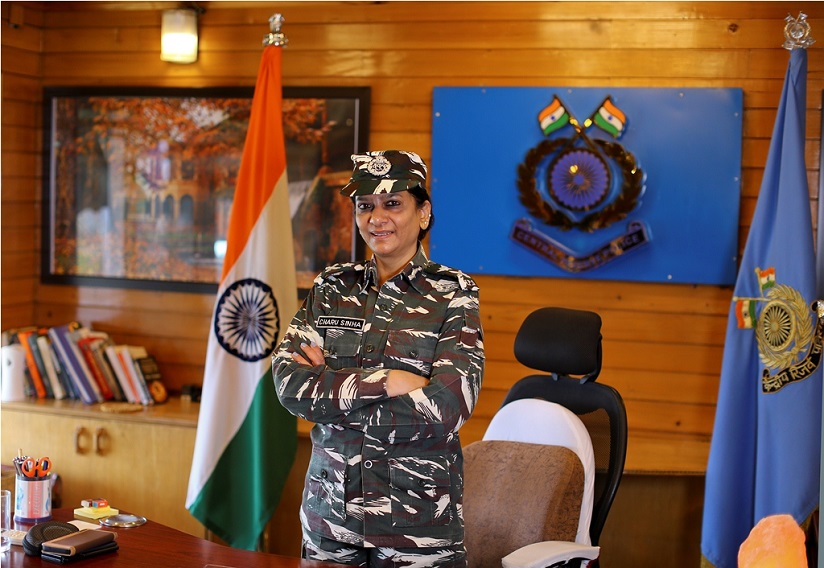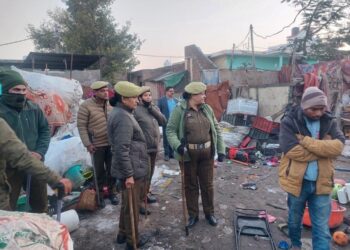
AMID the probable drawdown of army from Kashmir hinterlands, the outgoing Kashmir chief of Central Reserve Police Force (CRPF) has hinted at the pivotal role of the paramilitary forces in counter-insurgency operations in Kashmir now.
Charu Sinha’s comment came after her Central Kashmir tenure ended on Tuesday. “I see CRPF rising up to the challenge and working for the peace in the valley,” the CRPF’s woman Inspector General said.
A 1996-IPS batch officer of Telangana cadre, Sinha assumed the office of IG CRPF, Central Kashmir, in September 2020 — when Srinagar was witnessing a series of targeted killings.
Before coming to Kashmir, Sinha had her stint in Naxal heartlands. “Sinha demonstrated exceptional leadership skills and worked tirelessly to improve security scenario in the valley,” the CRPF said in a statement.
In a candid chat with Kashmir Observer, Sinha talks about her tenure, experience and challenges as a woman IPS officer in Kashmir.
You arrived in Srinagar amid targeted killings. What was your first response to the situation?
We at CRPF have a multipronged strategy to deal with the situation. So we tried to reach out to the targeted community and established contact with them. We tried our best to prevent untoward incidents in the area which came under our domain.
But how did Kashmir prove different from your earlier postings?
It was a new theatre. Earlier I had worked in Naxalite affected areas of Assam and Bihar. So, I had to learn everything from the beginning of how to handle the situation. And usually, as a woman, the first challenge is to be accepted by colleagues and subordinates.
How was tackling militancy different from Naxalism?
In urban operations and guerilla warfare, there is a hell lot of difference and I’m happy that I got to serve in both situations.
During your tenure, we saw women CRPF personnel frisking in Lal Chowk. They became regulars during street patrols and house searches. What was the thought-process behind it?
See, whenever we search or raid any house, we come across women who hesitate to talk to CRPF men. So, the motive was to indulge women personnel to deal with the Kashmiri female folks comprising fifty percent of the populace.
But in the name of security, many bunkers have cropped up in city and are causing a lot of inconvenience to people.
I am not in a position to answer this question.
Tell us something about the initiatives that CRPF took under your leadership?
CRPF held Ilmi Rozgaar for the youth-employment generation in the valley. We also organized sports events during summers and Jashn-e-chillai Kalan during winters.
CRPF reached out to orphanages and tried to establish contacts with youngsters. There is a high level of stress and a burden of patriarchy here, which causes problems among youth. We tied up with different universities and initiated a programme called Love Your Zindagi and it bore good results.
There are reports that CRPF and J&K police will replace Army in Hinterland. Do you think CRPF will be able to handle the counter-insurgency operations?
Yes, 100 percent.
How would you remember your tenure as a woman IPS officer in Kashmir?
It was an outstanding tenure. I’ve grown both professionally and individually. I’ve learnt a lot of things. The kind of issues we had here and navigating with those issues was a very learning experience.
I’m proud of what we’ve achieved together in the last two and a half years. The people of this region have been incredibly supportive, and we’ve been able to establish a strong foundation of trust and cooperation.
It’s not only the breathtakingly ethereal beauty of the place or the people, it’s also their simple way of life, the sheer pride they take in their culture and rich history, their age-old and inherent belief in spirituality, which would stay etched in my mind and remain with me forever. Kashmir will always be home and Kashmiris, family to me.
I pray to Allah to prevail peace in every nook and corner of the valley.
Follow this link to join our WhatsApp group: Join Now
Be Part of Quality Journalism |
Quality journalism takes a lot of time, money and hard work to produce and despite all the hardships we still do it. Our reporters and editors are working overtime in Kashmir and beyond to cover what you care about, break big stories, and expose injustices that can change lives. Today more people are reading Kashmir Observer than ever, but only a handful are paying while advertising revenues are falling fast. |
| ACT NOW |
| MONTHLY | Rs 100 | |
| YEARLY | Rs 1000 | |
| LIFETIME | Rs 10000 | |










